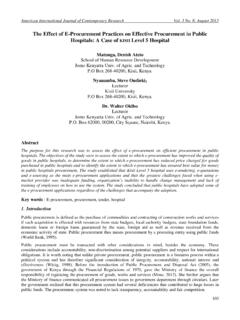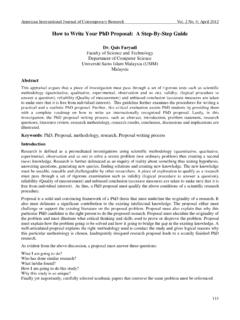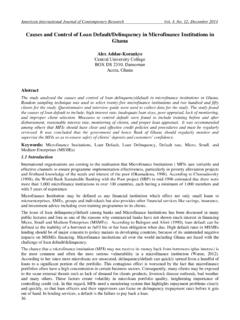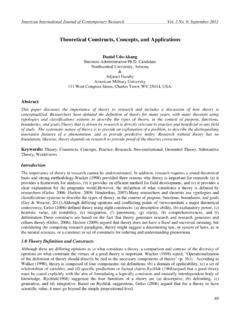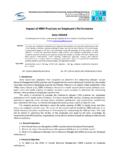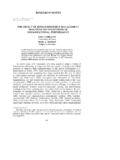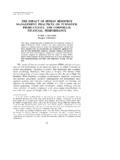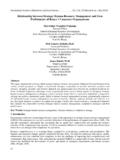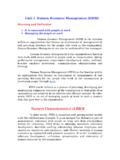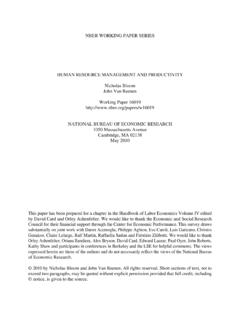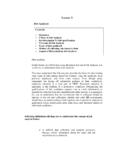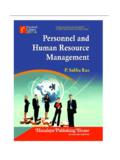Transcription of A Case Study of Human Resource Practices in a Private ...
1 American International Journal of Contemporary Research Vol. 2 No. 6; June 2012 207 A Case Study of Human Resource Practices in a Private Sector Pharmacy in Trinidad and Its Comparison to the Best Practice Model Sandeep MAHARAJ1, Shalimar ALI1, Alia HUSAIN1, Dushala PRASHAD1, Cassie JOSEPH1, Sureshwar PANDEY2 1,2 School of Pharmacy The University of the West Indies, St. Augustine Eric Williams Medical Sciences Complex Mount Hope, Trinidad & Tobago Abstract Objective: To conduct a case Study on the Human Resource Practices in a Pharmacy and compare their practice to the Best Practice Model. Method: An interview was conducted, with respect to the Human Resource Practice employed at a Private sector pharmacy. A list of the questions used as a guide during the interview is attached in Appendix 1.
2 The overall response rate was 100%. Results: The results obtained were summarized in a table. It showed at the pharmacy under Study adopts 6 of the 10 best Practices : Providing a Safe, Healthy and Happy Workplace, Providing Performance linked Bonuses, Utilization of 360 Degree Performance Management Feedback System, and Utilization of a Fair Evaluation System for Employees, Highlighting performers and Employing Open house discussions and feedback mechanisms. The Practices which are not carried out by the pharmacy include an Open book management style, knowledge sharing, reward ceremonies and surprising employees with unexpected rewards. Conclusion: From the interview it can be deduced that the pharmacy employs most of the Best Practices listed, with the results being reflected by its acclaimed customer service.
3 However it can be noted that to improve their Management they should attempt to utilize all the Practices listed. Keyword: Human Resource , Pharmacy, Case Study 1. Introduction There is a big secret in the Pharmaceutical Industry, one that if revealed prematurely to budding pharmacists will lead to the desiccation of the flood of Human Resource currently experienced in the industry. This paper however, is all about hitting the grisly truth, and that is; Pharmacists Need Managerial Skills for the success of their profession. This paper aims at highlighting one key aspect of successful managing, Human Resource Practices . One fundamental facet of what is called the New Workplace is being able to treat the worker as a Human Resource and this paper essentially deals with Human Resource Management in Pharmacies, with a look at a popular pharmacy chain in the Republic of Trinidad and Tobago.
4 Definition of Human Resource Management Human Resource Management is the understanding and application of the policies and procedures that directly affects the people working within the project team and the overall workforce. The management of the workforce of a business is important to guarantee sufficient staff levels with the right skills, properly rewarded and motivated. [1] It can be defined as a strategic and coherent approach to the management of an organization s working force who, both on an individual as well as a collective level, contribute to the achievement of its objectives. Storey (1989) considers that can be regarded as a set of interrelated policies with an ideological and philosophical underpinning . [2] Centre for Promoting Ideas, USA 208 is centered on achieving two main goals: achieving operational objectives of the organization and on ensuring that individual employees are satisfied with both the working environment and the benefits and compensation that they receive.
5 The characteristics of the concept throughout the years have been described as being diverse, strategic with an emphasis on integration, commitment-oriented, based on the belief that people should be treated as assets ( Human capital), individualistic rather than collective with respect to its employee relations, a management-driven activity and focused on business values. The purpose of Human Resource Management essentially, is to ensure that the organization is capable of achieving success via people. Ulrich and Lake (1990) remarked that, Human Resource Management systems can be the source of organizational capabilities that allow firms to learn and capitalize on new opportunities. [3] is focused on achieving organizational effectiveness, Human capital management, knowledge management, reward management, good employee relations, meeting diverse needs, and bridging the gap between rhetoric and reality.
6 Human Resources Management Practices are a fundamental requirements for a successful organization where different kinds of people are brought together to achieve a common purpose [4]. Human Resource management (HRM) is a philosophy of people management based on the belief that Human resources are equally effective in sustained business success [5, 6]. HRM is the process of managing Human talent to achieve an organization objective. By balancing competing demands, it plays an important role in getting the most from employees and providing a work environment that meets their short term and long term needs. An organization s success depends on the knowledge, skill and abilities of its employees. To ensure that of an organization is successful employees need to be acquainted with their organization s mission, their role, what is expected of them, must have the capacity; resources and environment which makes success possible and lastly must receive encouragement; constructive feedback and opportunities to improve and develop.
7 People strategic importance is growing in today s knowledge based industries hence the need for the management of Human resources. High performance and productivity are the result of promoting progressive Human Resource Practices by top managers. Organizations that succeed incorporate the Human Resource management process as a core component in formulating competitive strategic business plans. This allows for major trends to be quickly and efficiently recognized for the benefit of the entire organization. For the past decade, the focus of competitive strategic business plans mainly involved issues such as globalization, embracing new technology, managing change, talent or Human capital, responding to market and containing costs. These trends all require a skilled and flexible work force in order to compete in today s society.
8 In addition to competitive challenges facing organizations, managers, particularly HR managers, need to be concerned about changes in the makeup and the expectations of their employees. These changes mainly include demographic and cultural changes [4]. The Practices being dealt with in this literature are creating a working (safe and happy) environment, open management or management by objectives ( ), providing performance incentives, collecting performance feedback, conducting employee evaluations, sharing of knowledge, publicizing good performances, having open discussions with employees, offering rewards to employees for achievements and surprise. Creating a great place to work, ensures that future employees gain a desire to join the organization and once there, to want to stay. From a pharmacy perspective, Pharmacists can use this practice to encourage their employees to be committed to the pharmacy and become more engaged in the work they do.
9 Creating an environment with good employer-employee relationships also serves to strengthen the loyalties of the employees and in so doing reduce the staff turn-over rate in the pharmacy. On the basis of their longitudinal research in 12 companies, Purcell et al (2003) concluded that: What seems to be happening is that successful firms are able to meet people s needs both for a good job and to work in a great place . They create good work and a conducive working environment. In this way they become an employer of choice . People will want to work there because their individual needs are met for a good job with prospects linked to training, appraisal, and working with a good boss who listens and gives some autonomy but helps with coaching and guidance. [7] American International Journal of Contemporary Research Vol.
10 2 No. 6; June 2012 209 Management by Objectives ( ) is a process of agreeing upon goals and/or objectives between management and employees within an organization. aims at increasing organizational performance and intends to make sure that everyone understands what they are in the organization, and has a clear understanding of the aims/objectives of that organization, as well as awareness of their own roles and responsibilities in achieving those aims. In the Pharmacy, this may manifest by outlining the roles of each position in the pharmacy and assigning specific objectives to each employee, with guidance from employees themselves. The purpose of this is thought to be that when employees themselves have been involved with the goal setting and the choosing the course of action to be followed by them, they are more likely to fulfill their responsibilities.
